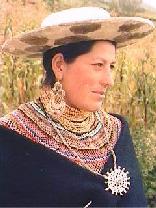
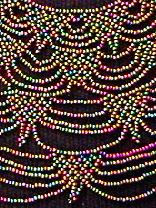 Saraguro women (and a few men) make a large variety of beautiful beadwork necklaces
("collares"), as well as bracelets and bags.
Saraguro women (and a few men) make a large variety of beautiful beadwork necklaces
("collares"), as well as bracelets and bags.


 Saraguro women (and a few men) make a large variety of beautiful beadwork necklaces
("collares"), as well as bracelets and bags.
Saraguro women (and a few men) make a large variety of beautiful beadwork necklaces
("collares"), as well as bracelets and bags.
These are available in a variety of shops in or near the center of town (and
in other parts of Ecuador such as Quito, where they are made by Saraguros or
copied by non-Saraguros). Click here for lots more.
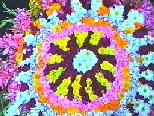 Saraguro women make gorgeous floral wreaths ("ramos") for a variety
of occasions. Check near the altar in the front of the church in the center
of town for the best examples; other churches and chapels in the region may
also have them.
Saraguro women make gorgeous floral wreaths ("ramos") for a variety
of occasions. Check near the altar in the front of the church in the center
of town for the best examples; other churches and chapels in the region may
also have them.
Click here for more information and photographs.
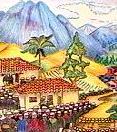 A
number of Saraguros draw and/or paint pictures and murals.
A
number of Saraguros draw and/or paint pictures and murals.
At least artist one has illustrated books and sold some of his artwork. Click
here to see examples of his work. Murals by this
artist may also be seen on the school building in Lagunas.
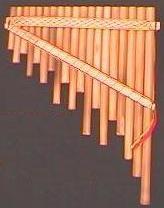 It is important to the Saraguros that they maintain much of their (now somewhat
modified) musical tradition. Several musical groups play excellent music, but
they may not be performing locally when you are there--they might be playing
in your hometown in the US!. For information on two Saraguro groups who have
performed in the United States click here.
It is important to the Saraguros that they maintain much of their (now somewhat
modified) musical tradition. Several musical groups play excellent music, but
they may not be performing locally when you are there--they might be playing
in your hometown in the US!. For information on two Saraguro groups who have
performed in the United States click here.
If you have a chance to attend or observe a fiesta or a wedding celebration you will see one kind of traditional music. It is performed by two musicians, one plays a drum and the other plays either a violin or a concertina.
When we first arrived in Saraguro in the 1960s there were almost no radios, tape recorders or record players in the area (and forget about TV). People made their own music. Mothers sang to their children, everybody sang in church, the musicians mentioned above played at fiestas and funerals and weddings, and young men played rondadores (panpipes) as they watched over their flocks in the mountains. It was a magical time: clouds drifting across Andean Peaks; the music of rondadores drifting across the valleys (click here to read a similar impression from 1930 [in Spanish]) ... And then the radio came, and it was Ecuadorian popular music and international rock. And then came tape players, and TV and CD players, and "discomobiles." ... So Saraguros have certainly expanded their musical tastes. But never fear, there are still many Saraguros playing and singing and composing one variant or another of their own and other forms of Andean music.
Some musical instruments are still made in Saraguro. Click on the following to see them: antara, bombo, chacchas, palla, quenas, rondadores, sikus, vaina, zampoña.
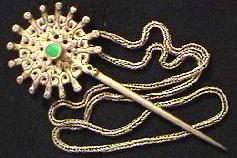
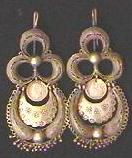 Silver jewelry such as tupos and earrings are made for the indigenous population
by non-indigenous artisans in the area. They are available in shops around town.
Silver jewelry such as tupos and earrings are made for the indigenous population
by non-indigenous artisans in the area. They are available in shops around town.
By tradition, both the tupos and the earrings worn by Saraguro women often have a silver chain attached. Tupos are used to hold the shawl together in front; their pointed ends are also useful for various activities (including defense). The Saraguro woman shown in the section on beadwork is wearing a tupo and the large earrings of traditional style.
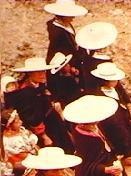 In the early 1960s Saraguros often wore very heavy, wide brimmed, pressed wool
hats. These were made by non-indigenous artisans in town. While other kinds
of hats have superceded these hats for ordinary, daily wear, the traditional
hat may be worn for dressy occasions. So you will probably still see them in
Saraguro, but, unfortunately, they are no longer being made.
In the early 1960s Saraguros often wore very heavy, wide brimmed, pressed wool
hats. These were made by non-indigenous artisans in town. While other kinds
of hats have superceded these hats for ordinary, daily wear, the traditional
hat may be worn for dressy occasions. So you will probably still see them in
Saraguro, but, unfortunately, they are no longer being made.
The picture on the left was taken in 1963. The Saraguro woman shown in the
section on beadwork is wearing a traditional hat.

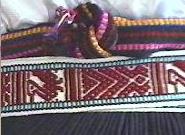 In the 1960s most Saraguro families made most of their clothing. They raised
their own sheep, and women spun the wool, and, using backstrap looms, men wove
the yarns into cloth. Today far fewer families engage in the entire process.
Nevertheless, in the shops around town you can still find woven belts, "fajas,"
such as those pictured here, as well as shawls and tablecloths and other locally
woven items.
In the 1960s most Saraguro families made most of their clothing. They raised
their own sheep, and women spun the wool, and, using backstrap looms, men wove
the yarns into cloth. Today far fewer families engage in the entire process.
Nevertheless, in the shops around town you can still find woven belts, "fajas,"
such as those pictured here, as well as shawls and tablecloths and other locally
woven items.
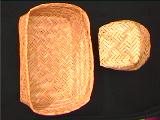 Saraguros make a variety of baskets (shown in the photo) as well as fire-fans
and mats ("esteras").
Saraguros make a variety of baskets (shown in the photo) as well as fire-fans
and mats ("esteras").
Locally made basket-work is usually available in the covered market area in
the town of Saraguro.
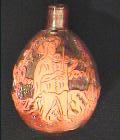
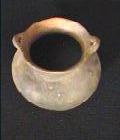
Many bowls, pots and other ceramic materials used in the area used to be made by local potters. However, the last potter in the area making these items in the traditional manner quit making pottery in the 1990s. An example of her work is on the right.
Today there are several indigenous people making modern pottery with electric
kilns in the Saraguro area. This pottery comes in a variety of styles and is
decorated with Saraguro motiffs.
LEATHERWORK: BELTS AND MACHETE CASES
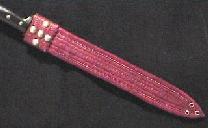
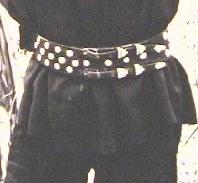 The
making of men's wide, metal studded belts, with pockets, and the making of machete
cases is done by non-indigenous artisans in the area.
The
making of men's wide, metal studded belts, with pockets, and the making of machete
cases is done by non-indigenous artisans in the area.
Machete cases can easily be found in shops around town. Because few men wear
the "traditional" leather belts any more, except for special occasions, they
may be harder to find.
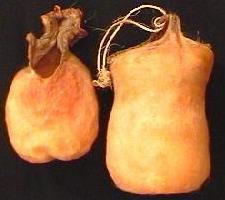 Saraguros don't make steers out of their bulls (they prefer to use bulls rather
than steers for plowing, among other things). When a bull dies or is slaughtered
locally, its well-developed "equipment" is removed and made into bags which
are hung on a peg in the house wall and used to contain odds and ends.
Saraguros don't make steers out of their bulls (they prefer to use bulls rather
than steers for plowing, among other things). When a bull dies or is slaughtered
locally, its well-developed "equipment" is removed and made into bags which
are hung on a peg in the house wall and used to contain odds and ends.
These rawhide bags seem to be strictly for family use, as available. We have
not seen them for sale in any Saraguro shops.
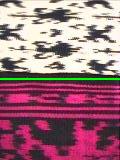
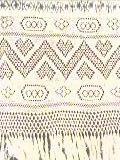 Macanas are warp-tie-dyed (ikat) shawls sometimes worn by Saraguro women--these
days they are still highly valued for use on special occasions. The warp yarns
are knotted in a decorative pattern at both ends of the macana. The photograph
to the left shows the tie-dye elements of two macanas. To the right is the knotted
fringe.
Macanas are warp-tie-dyed (ikat) shawls sometimes worn by Saraguro women--these
days they are still highly valued for use on special occasions. The warp yarns
are knotted in a decorative pattern at both ends of the macana. The photograph
to the left shows the tie-dye elements of two macanas. To the right is the knotted
fringe.
Macanas are not made in the Saraguro area but in the province of Azuay, to
the north. Unfortunately, warp-tie-dyed cloths of this sort are increasingly
hard to find anywhere in Ecuador.
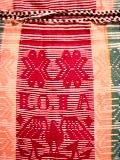
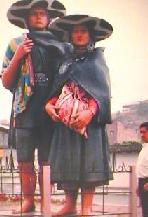 Alforjas
are made like saddle-bags and are used for that purpose. However, they are more
commonly used by Saraguros (especially men) to carry things in, themselves.
Alforjas
are made like saddle-bags and are used for that purpose. However, they are more
commonly used by Saraguros (especially men) to carry things in, themselves.
In the past carrying an alforja was almost a part of being completely dressed for a man--especially for a photograph. Today backpacks, and locally woven bags with straps have to some extent replaced the alforja for carrying things.
The photograph on the right is of a statue of traditionally dressed Saraguros, carrying alforjas, in the city of Loja. Saraguros are annoyed by implication that the man would be carrying an empty alforja while the woman would be carrying a loaded one. "Not the way it is!" they say.
These bags are not made in the Saraguro area, but by artisans in the vicinity
of Loja. However, they can be obtained from various shops in Saraguro.
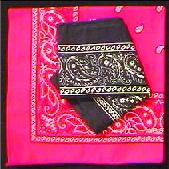 OK, bandana handkerchiefs are not a result craft-work in either Saraguro
or the rest of Ecuador! However, since the 1960s they have been very popular
and are now well integrated into Saraguro life. They are not used to clean one's
nose (horrors! that's what Jim did with them), but are used for decorating altars
and other things, for carrying bags, for head coverings for infants and young
children, for special-occasion "shawls" for small children, for men to wave
around in dances, etc.
OK, bandana handkerchiefs are not a result craft-work in either Saraguro
or the rest of Ecuador! However, since the 1960s they have been very popular
and are now well integrated into Saraguro life. They are not used to clean one's
nose (horrors! that's what Jim did with them), but are used for decorating altars
and other things, for carrying bags, for head coverings for infants and young
children, for special-occasion "shawls" for small children, for men to wave
around in dances, etc.
Saraguros are particular about their bandanas--they must be printed on both sides and have firm colors and nice designs. They also appreciate similar qualities in other cloths of the same size such as indigo-dyed cloths, with designs, from China or Japan.
Because they are rather difficult to obtain--and expensive--in Ecuador, bandanas
are appreciated as gifts. Pack away several to take to Saraguro with you!


The background design on this page
comes from a Saraguro wool poncho
woven with paired yarns on a back-strap loom.